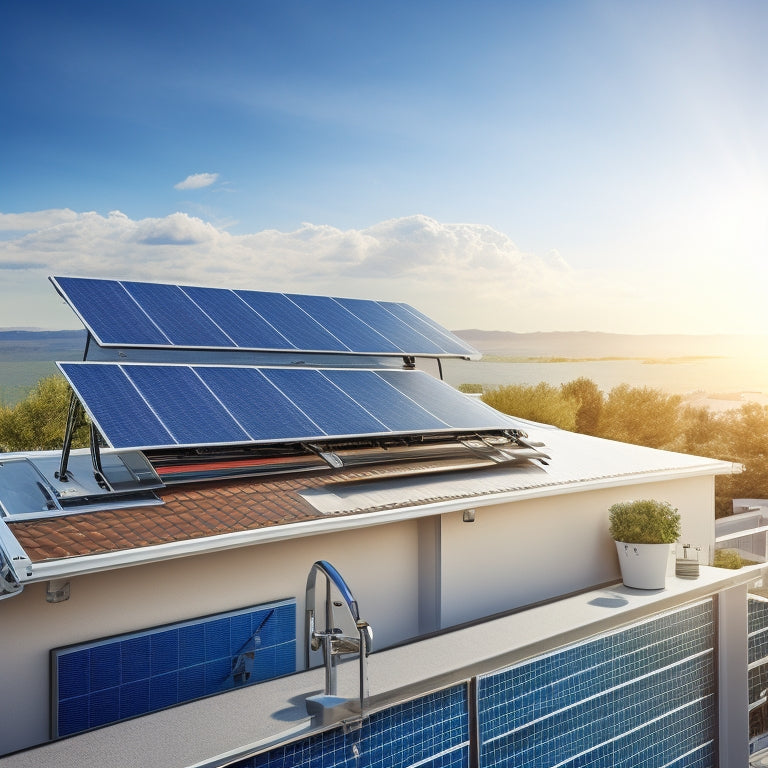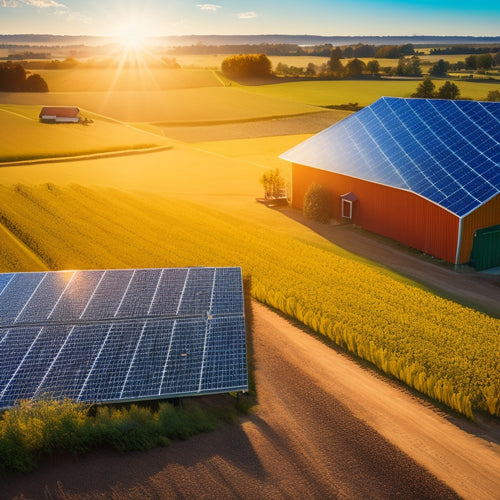
A 7-Step Guide to Installing Home Solar Power Systems
Share
You're ready to utilize the power of the sun and reduce your carbon footprint. To successfully install a home solar power system, start by evaluating your energy needs, choosing the right equipment, and assessing your roof's condition. Next, obtain necessary permits, and then install solar panels properly, considering factors like orientation and safety. Connect your system to the grid, ensuring utility requirements are met. Finally, monitor your system's performance to maximize energy output and savings. By following these 7 steps, you'll be well on your way to generating clean energy and cutting your energy bills - and there's more to investigate in each of these critical stages.
Key Takeaways
- Assess energy needs by evaluating consumption patterns and calculating total daily energy usage to determine the required solar power system size.
- Select suitable solar panels based on energy requirements, compatibility with system components, and efficiency metrics such as panel type, wattage, and durability.
- Ensure system component compatibility by choosing an inverter, mounting system, and racking system that work together seamlessly to maximize energy production and longevity.
- Evaluate the roof's condition, size, and shape to ensure it can accommodate the solar panel system, and conduct a structural integrity check to identify potential weaknesses or defects.
- Obtain necessary permits and comply with local building codes and regulations to avoid fines, penalties, or project cancellation.
Assessing Your Energy Needs
To determine the feasibility of a home solar power installation, evaluating your energy needs is the essential first step.
You'll need to evaluate your energy consumption patterns to determine how much power you require. This involves analyzing your past utility bills to identify your peak energy usage periods and overall energy consumption. You'll want to calculate your total daily energy usage in watt-hours (Wh) and identify areas where you can reduce consumption.
Next, consider your energy goals. Do you want to power your entire home with solar energy, or just supplement your existing power source? Knowing your energy goals will help you determine the size of the solar power system you'll need.
Additionally, understanding your energy needs will help you take advantage of financial incentives, such as tax credits and rebates, which can offset the cost of your solar power installation. By accurately evaluating your energy needs, you'll be able to determine the most cost-effective and efficient solar power solution for your home.
Choosing the Right Equipment
You'll need to select solar panels that meet your energy requirements and guarantee compatibility with other system components.
The type and quality of solar panels will greatly impact your system's overall performance and efficiency.
When choosing equipment, it's crucial to take into account factors such as panel wattage, voltage, and durability to guarantee a reliable and efficient home solar power system.
Solar Panel Selection
Selecting the right solar panels is a critical step in your home solar power installation, as it directly impacts the system's efficiency, reliability, and overall cost. You'll want to choose panels that cater to your energy needs and budget.
When evaluating solar panels, consider the following key factors:
| Factor | Description |
| Efficiency | Measures the panel's ability to convert sunlight into electricity. Higher efficiency means more power per unit area. |
| Cell Type | Monocrystalline cells offer higher efficiency, while polycrystalline cells are more budget-friendly. |
| Warranty | Look for manufacturers offering 25-year warranties or more for performance and materials. |
| Durability | Assess the panel's durability by checking its IP rating, which measures resistance to water and dust.
Recent solar technology advancements have led to significant improvements in solar panel efficiency, making it possible to generate more power from a smaller surface area. By considering these factors, you'll be able to select the right solar panels for your home solar power installation, ensuring maximum energy output and cost savings.
System Component Compatibility
With your solar panels chosen, it's crucial to guarantee that all system components work in harmony to maximize energy production and longevity. This means selecting equipment that's compatible with your specific system type and panel configuration.
You'll need to choose an inverter that matches your system's voltage and current output. String inverters are ideal for residential systems, while central inverters are better suited for larger commercial installations. Microinverters, on the other hand, are perfect for systems with multiple orientations or shading issues.
In addition, you'll need a mounting system that securely fastens your panels to your roof or ground. Be sure to select a racking system compatible with your roof type and local building codes.
Moreover, consider a monitoring system to track your energy production and identify potential issues. By selecting the right equipment, you'll guarantee a seamless and efficient energy-generating experience.
Evaluating Your Roof's Condition
You'll need to assess your roof's condition to guarantee it can support the added weight and stress of solar panels.
Start by evaluating your roof's age and life expectancy, as well as its size and shape, to determine if it's suitable for solar installation.
Additionally, you'll need to perform a structural integrity check to identify any potential weaknesses or defects that could impact the installation or safety of your solar power system.
Roof Age and Life
Evaluating your roof's condition is an essential step in determining its viability for a home solar power installation.
You'll need to assess the roof's age and life expectancy to ascertain it can support the added weight and durability requirements of solar panels. Typically, a roof with 10-15 years or more of life remaining is suitable for solar installation.
Check your roof's materials, such as asphalt shingles, metal, or clay tiles, and consider their maintenance history. Review your roof warranties, which often cover repairs and replacements for a certain period.
Also, inspect the roof's insulation, ventilation, and aesthetics, including its color, to guarantee they won't be compromised by the solar panels.
If your roof requires significant repairs or replacement soon, it might be wise to address those issues before investing in solar power.
Roof Size and Shape
The roof's size and shape play an essential role in determining the suitability of your home for solar power installation.
You'll want to evaluate your roof's dimensions to verify it can accommodate the solar panel system you need. A larger roof generally allows for more solar panels, increasing your energy production. However, a smaller roof can still support a solar power system, albeit with fewer panels.
Examine your roof's orientation, as a south-facing roof receives the most sunlight throughout the day. East- and west-facing roofs are also suitable, but north-facing roofs may not be ideal.
Conduct a shading analysis to identify any obstructions, such as trees, chimneys, or neighboring buildings, that could cast shadows on your roof. This analysis will help you determine the best placement for your solar panels to maximize energy production.
Consider using a solar panel layout tool or consulting with a professional to optimize your system's design. By carefully evaluating your roof's size and shape, you can guarantee a successful solar power installation that meets your energy needs.
Structural Integrity Check
Evaluating your roof's structural integrity is an important step in the solar power installation process, as it directly impacts the safety and performance of your solar panel system.
You'll need to assess your roof's load-bearing capacity to guarantee it can support the weight of the solar panels, mounting hardware, and other equipment. A thorough inspection will help identify any potential issues, such as damaged or rotten rafters, sagging or uneven rooflines, or signs of wear and tear.
Next, you'll want to examine your roof's weather resistance. Check for damaged, missing, or loose shingles, curled or buckled roofing material, and signs of water damage or leaks.
Make certain your roof is securely fastened to the walls and that all flashing is in good condition. Additionally, inspect your roof's drainage system to make sure it can handle the added weight of snow and water.
Any defects or weaknesses in your roof's structure or weather resistance can compromise the safety and efficiency of your solar panel system, so it's vital to address these issues before installation.
Obtaining Necessary Permits
You'll need to obtain necessary permits before commencing your home solar power installation project, as these documents guarantee compliance with local building codes, electrical safety standards, and zoning regulations. Failure to secure the required permits can result in fines, penalties, and even project cancellation.
Permit Requirements Breakdown
| Permit Type | Description |
|---|---|
| Building Permit | Assures compliance with local building codes and zoning laws |
| Electrical Permit | Verifies electrical safety standards and connections |
| Zoning Permit | Confirms project compliance with local zoning regulations |
The permit timeline typically ranges from a few weeks to several months, depending on the complexity of your project and the efficiency of your local authorities. You'll need to submit a detailed application, including project plans, specifications, and environmental impact assessments. Be prepared for inspections and potential revisions to your plans. It's crucial to consult with local authorities and a licensed solar installer to maneuver through the permit process efficiently.
Installing Solar Panels Properly
Get set to roll out your solar panel installation by guaranteeing a proper setup, as it's essential for utilizing maximum energy and preventing potential hazards.
You'll want to begin by determining the ideal solar panel orientation for your roof, considering factors like shading, roof pitch, and local building codes. This will guarantee you're leveraging the most energy possible from the sun.
When it comes to installation safety, make sure you're wearing appropriate personal protective equipment, such as gloves and a safety harness, to prevent falls and electrical shock. Use a sturdy ladder and maintain three points of contact at all times.
Confirm the roof is clear of debris and obstructions, and think about hiring a professional if you're not comfortable with heights or electrical work.
Properly secure the panels to the roof using approved fasteners and flashing, and verify the system's electrical connections meet local building codes.
Connecting to the Grid
With your solar panel installation properly set up, it's time to think about connecting your system to the grid. This essential step allows you to sell any excess energy generated back to the utility company and offset your energy bills.
To guarantee a seamless grid connection, you'll need to meet the utility company's requirements.
Here are the key considerations for a successful grid connection:
-
Utility requirements: Familiarize yourself with the utility company's interconnection standards, which may include specific equipment, installation, and testing requirements.
-
Grid tie inverter: Install a grid tie inverter that synchronizes your solar power output with the grid's frequency and voltage.
-
Net metering: Confirm you have a net meter installed to measure the excess energy you produce and feed back into the grid.
-
Grid connection equipment: Use approved equipment, such as a grid connection box, to safely connect your system to the grid.
-
Inspection and testing: Schedule an inspection and testing with the utility company to verify your system meets their requirements and is safe to operate.
Monitoring System Performance
Now that your solar panel system is connected to the grid, it's essential to keep track of its performance to guarantee you're maximizing your energy production and savings.
You'll want to utilize advanced monitoring technologies to confirm your system is operating at peak levels. This involves tracking key performance metrics, such as energy output, system efficiency, and temperature.
By monitoring these metrics, you can identify potential issues and make data-driven decisions to enhance your system's performance. For instance, if you notice a drop in energy output, you can investigate the cause and take corrective action to get your system back on track.
Effective monitoring also enables you to verify the accuracy of your system's performance predictions, assuring you're getting the most out of your investment.
Frequently Asked Questions
Can I Install Solar Panels on My Own Without Professional Help?
You can attempt a DIY installation, but it's essential to prioritize safety considerations, ensuring you're comfortable with electrical and roofing work, and can maneuver complex system design and permitting requirements.
How Long Does a Typical Solar Panel Warranty Last?
You'll typically find that a solar panel warranty lasts around 25 years, covering defects and ensuring a minimum solar panel lifespan of 80% capacity; this warranty coverage provides peace of mind for your long-term power generation needs.
Are There Any Tax Incentives for Residential Solar Installations?
You're about to hit the jackpot! With residential solar installations, you're eligible for incredible federal tax incentives, plus state rebates that can total up to 30% of your system's cost - that's thousands of dollars back in your pocket!
Can I Use Solar Power to Charge My Electric Vehicle?
You can use solar power to charge your electric vehicle, leveraging solar charging to offset fuel costs and reduce your carbon footprint; with a properly sized solar array, you'll be driving green in no time.
Do Solar Panels Work During Power Outages?
You're stuck in the dark, but don't worry, you can shine on! Solar panels won't work during power outages without a battery backup or grid-tie inverter, but with the right setup, you'll be humming along, generating electricity like a pro, even when the grid goes dark!
Conclusion
You've successfully installed your home solar power system! By following these 7 steps, you've not only reduced your carbon footprint but also invested in a clean and sustainable energy source. Did you know that in 2020, solar power accounted for 43% of all new electricity generating capacity in the US? As you start generating your own clean energy, remember to regularly monitor your system's performance to guarantee maximum efficiency and reap the benefits of your investment.
Related Posts
-

Off-Grid Solar Solutions for Sustainable Farming
Off-grid solar solutions can revolutionize your farming operations by providing energy independence and significant c...
-

Integrating Smart Technology for Energy Savings
Integrating smart technology into your home is a transformative factor for energy savings. Smart thermostats give you...
-

Eco-Friendly Home Design Ideas for Beginners
If you're starting your eco-friendly home design expedition, focus on sustainable materials like recycled wood or rec...


